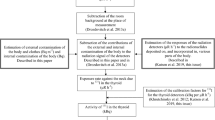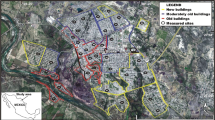Abstract
This paper describes the calculation of the response of the most common types of radiation detectors that were used within the first few weeks after the Chernobyl accident to determine the activity of 131I in the thyroids of Belarusian subjects of an epidemiologic study of thyroid cancer. The radiation detectors, which were placed against the necks of the subjects, measured the exposure rates due to the emission of gamma rays resulting from the radioactive decay of 131I in their thyroids. Because of the external and internal radioactive contamination of the monitored subjects, gamma radiation from many radionuclides in various locations contributed to the exposure rates recorded by the detectors. To estimate accurately the contribution from gamma rays emitted from various internal and external parts of the body, the calibration factors of the radiation detectors, expressed in kBq per µR h− 1, were calculated, by means of Monte Carlo simulation, for external irradiation from unit activities of 17 radionuclides located on 19 parts of the body, as well as for internal irradiation from the same 17 radionuclides in the lungs, from caesium radionuclides distributed uniformly in the whole body, and from 131I in the thyroid. The calculations were performed for six body sizes, representative of the age range of the subjects. In a companion paper, the levels of external and internal contamination of the body were estimated for a variety of exposure conditions. The results presented in the two papers were combined to calculate the 131I activities in the thyroids of all 11,732 Belarusian study subjects of an epidemiologic study of thyroid cancer and, in turn, their thyroid doses.




Similar content being viewed by others
References
Briesmeister JF (1994) MCNP—a general Monte Carlo n-particle transport code. Version 4A. Report No LA-12625-M. Los Alamos National Laboratory, Radiation Shielding Information Center, Los Alamos
Cristy M (1980) Mathematical phantoms representing children of various ages for use in estimates of internal dose. Report No ORNL/NUREG/TM-367. Oak Ridge National Laboratory, Oak Ridge
Cristy M, Eckerman KF (1987) Specific absorbed fractions of energy at various ages from internal photon sources. Report No ORNL/TM-8381/V1. Oak Ridge National Laboratory, Oak Ridge
Drozdovitch V, Minenko V, Khrouch V, Leshcheva S, Gavrilin A, Khrutchinsky A, Kukhta T, Kutsen S, Luckyanov N, Shinkarev S, Tretyakevich S, Trofimik S, Voillequé P, Bouville A (2013) Thyroid dose estimates for a cohort of Belarusian children exposed to radiation from the Chernobyl accident. Radiat Res 179:597–609
Drozdovitch V, Minenko V, Golovanov I, Khrutchinsky A, Kukhta T, Kutsen S, Luckyanov N, Ostroumova E, Trofimik S, Voillequé P, Simon SL, Bouville A (2015) Thyroid dose estimates for a cohort of Belarusian children exposed to 131I from the Chernobyl accident: assessment of uncertainties. Radiat Res 184:203–218
Drozdovitch V, Khrouch V, Minenko V, Konstantinov Y, Khrutchinsky A, Kutsen S, Kukhta T, Shinkarev S, Gavrilin Y, Luckyanov N, Voillequé P, Bouville A (2019) Influence of the external and internal radioactive contamination of the body and of the clothes on the results of the thyroidal 131I measurements conducted in Belarus after the Chernobyl accident. Part 1: estimation of the external and internal radioactive contamination. Radiat Environ Biophys. https://doi.org/10.1007/s00411-019-00784-3 (this issue)
Gavrilin YuI, Khrouch VT, Shinkarev SM, Krysenko NA, Skryabin AM, Bouville A, Anspaugh L, Straume T (1999) Chernobyl accident: reconstruction of thyroid dose for inhabitants of the Republic of Belarus. Health Phys 76:105–119
ICRP—International Commission on Radiological Protection (1983) Radionuclide transformations—energy and intensity of emissions. ICRP Publication 38. Ann. ICRP 11–13. http://www.icrp.org/publication.asp?id=ICRP%20Publication%2038
ICRP—International Commission on Radiological Protection (2008) Nuclear decay data for dosimetric calculations. ICRP Publication 107. Ann. ICRP 38 (3). http://www.icrp.org/publication.asp?id=ICRP%20Publication%20107
Kaidanovsky GN, Dolgirev EI (1997) Calibration of radiometers for mass control of incorporated 131I, 134Cs and 137Cs nuclides with the help of volunteers. Radiat Prot Dosim 71:187–194
Khrutchinsky A, Drozdovitch V, Kutsen S, Minenko V, Khrouch V, Luckyanov N, Voillequé P, Bouville A (2012) Mathematical modeling of a survey-meter used to measure radioactivity in human thyroids: Monte Carlo calculations of device response and uncertainties. Appl Radiat Isotopes 70:743–751
Korn GA, Korn TM (1968) Mathematical handbook for scientists and engineers. McGraw-Hill, New York
Likhtarev IA, Shandala NK, Goulko GM, Kairo IA, Chepurny NI (1993) Ukrainian thyroid doses after the Chernobyl accident. Health Phys 64:594–599
Likhtarev IA, Goulko GM, Sobolev BG, Kairo IA, Pröhl G, Roth P, Henrichs K (1995) Evaluation of the 131I thyroid-monitoring measurements performed in Ukraine during May and June of 1986. Health Phys 69:6–15
Stezhko VA, Buglova EE, Danilova LI, Drozd VM, Krysenko NA, Lesnikova NR, Minenko VF, Ostapenko VA, Petrenko SV, Polyanskaya ON, Rzheutski VA, Tronko MD, Bobylyova OO, Bogdanova TI, Ephstein OV, Kairo IA, Kostin OV, Likhtarev IA, Markov VV, Oliynik VA, Shpak VM, Tereshchenko VP, Zamotayeva GA, Beebe GW, Bouville AC, Brill AB, Burch JD, Fink DJ, Greenebaum E, Howe GR, Luckyanov NK, Masnyk IJ, McConnell RJ, Robbins J, Thomas TL, Voillequé PG, Zablotska LB, Chornobyl Thyroid Diseases Study Group of Belarus, Ukraine, and the USA (2004) A cohort study of thyroid cancer and other thyroid diseases following the Chornobyl accident: objectives, design, and methods. Radiat Res 161:481–492
Ulanovsky AV, Eckerman KF (1998) Modification of ORNL phantom series in simulation of the responses of thyroid detectors. Radiat Prot Dosim 79:429–432
Ulanovsky A, Minenko V, Korneev S (1997) Influence of measurement geometry on the estimate of 131I activity in the thyroid: Monte Carlo simulation of a detector and a phantom. Health Phys 72:34–41
Ulanovsky A, Drozdovitch V, Bouville A (2004) Influence of radionuclides distributed in the whole body on the thyroid dose estimates obtained from direct thyroid measurements made in Belarus after the Chernobyl accident. Radiat Prot Dosim 112:405–418
UNSCEAR—United Nations Scientific Committee on the Effects of Atomic Radiation Sources and Effects of Ionizing Radiation (2011) UNSCEAR 2008 Report. Annex D: health effects due to radiation from the Chernobyl accident. Sales No. E.11.IX.3. United Nations, New York
Zvonova IA, Balonov MI, Bratilova AA (1998) Thyroid dose reconstruction for population of Russia suffered after the Chernobyl accident. Radiat Prot Dosim 79:175–178
Acknowledgements
This work was supported by the Intramural Research Program of the National Cancer Institute (NCI, USA), Division of Cancer Epidemiology and Genetics within the framework of the Belarus-U.S. Study of Thyroid Cancer and Other Diseases Following the Chernobyl Accident (Protocol #OH95-C-NO21); the ISTC Project #B-488p; the Intra-Agency Agreement between the National Institute of Allergy and Infectious Diseases (NIAID, USA) and the NCI, NIAID agreements #Y2-Al-5077 and #DCC-OD-12-900. The authors would like to thank Valery Kozhemyakin and Vladimir Guzov (SPE “Atomtex”, Minsk, Belarus), who contributed to the experimental estimation of the scaling coefficients of the devices.
Author information
Authors and Affiliations
Corresponding author
Additional information
Publisher’s Note
Springer Nature remains neutral with regard to jurisdictional claims in published maps and institutional affiliations.
Appendix: Technique to accelerate Monte Carlo calculations for a radiation source uniformly distributed on a curved surface
Appendix: Technique to accelerate Monte Carlo calculations for a radiation source uniformly distributed on a curved surface
Local weight procedure
To accelerate Monte Carlo calculations for a radiation source uniformly distributed on a body surface, a special procedure was developed that uses the local weight of the particle.
A uniformly contaminated curved surface area can be presented as a sum of elementary surface sources with activity proportional to their area. The weight w of each elementary surface source (weight of the particle) is determined by dividing its area by the total area of all elementary sources of a given area. In the proposed variant, the value of w is not a constant for the particle in the given cell but is proportional to the area of the surface element dσ(x,y,z) in photon position (x,y,z). If the surface is given parametrically r = r (u, v) (u, v are the coordinates given on the surface), then the area element dσ on it can be written as dσ = wL × du × dv, where wL can be used as the local weight of the particle at the point u, v on the surface.
Using equations of differential geometry (Korn and Korn 1968), the local weights for each type of body surface were found to be:
where θ and φ are the polar and azimuth angles, respectively. The azimuth angle was uniformly sampled in the interval (0,2π), while for the polar angle the quantity cosθ was uniformly sampled in corresponding sectors.
In Eqs. (10)–(12), a, b, and c are the semi-axes of the relevant ellipsoids or elliptic cylinders, and r is the radius of right circular cylinder, in particular:
where at and bt are the body semi-axes, ah and bh are the head semi-axes, ch2is the height of the elliptic head top, bsh, y0sh are parameters in Eq. 12 describing the parabolic shape of the trunk (Ulanovsky and Eckerman 1998), rn is the radius of the neck. Values of parameters for the family of ORNL human phantoms are given in Table 10. The family of ORNL human phantoms is represented as erect with the position z-axis directed upward toward the head. The x-axis is directed to the phantom’s left, and the y-axis is directed toward the posterior side of the phantom. The origin is taken at the center of the base of the trunk section of the phantom.
The result for a surface under consideration (tally in MCNP) was normalized to the sum of local weights for this surface. The validity of this procedure of using local weights was verified for regular surfaces such as sphere and circular cylinder, by comparison with the built-in MCNP values.
Auxiliary means for improvement of calculation efficiency
It should be noted that the variance reduction technique cannot be applied to the spectrum tally F8 usually used for the SRP-68-01 device with a scintillation detector. For the DP-5 it was necessary to use flux tally (F1 in MCNP) instead of the spectrum (F8 in MCNP) and specify the relative cells importance in the sample problem to help particles move more easily to the important regions of the geometry. Such variance reduction technique for the DP-5 is matched with the FORTRAN sub-routine “source.f” which was developed for the implementation of the local weights approach.
To process the information from the MCNP results, a special script, written in Perl language, was developed. This script arranges a cycle by desired energies from the list, inserting the required energy (and the corresponding number of histories) at each step of the cycle into the same input file. As soon as the MCNP code calculated the response function, the Perl script prepared a two-dimensional array (energy, response function) which was ready for use to calculate the calibration factor.
Rights and permissions
About this article
Cite this article
Kutsen, S., Khrutchinsky, A., Minenko, V. et al. Influence of the external and internal radioactive contamination of the body and the clothes on the results of the thyroidal 131I measurements conducted in Belarus after the Chernobyl accident—Part 2: Monte Carlo simulation of response of detectors near the thyroid. Radiat Environ Biophys 58, 215–226 (2019). https://doi.org/10.1007/s00411-019-00785-2
Received:
Accepted:
Published:
Issue Date:
DOI: https://doi.org/10.1007/s00411-019-00785-2




